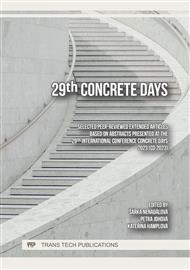p.45
p.53
p.59
p.71
p.79
p.93
p.101
p.113
p.121
The Impact of Hydration Heat on the Formation of Cracks in Massive Concrete Structures
Abstract:
The article deals with the analysis of the development of hydration heat in massive concrete structures and focuses mainly on risk factors which could lead to the appearance of early age cracking in the structure shortly after concreting. As part of the analysis, a parametric study was carried out, which was focused not only on the size of cracks on the surface of the structure, but also on the evaluation of the temperature gradient, where the ratio of the temperature difference and the distance between two points was investigated. During the study, different variants of the type and length of surface covering and different boundary conditions in terms of ambient temperature during individual seasons were considered. The numerical analysis was performed using nonlinear numerical calculations in ATENA software. At the conclusion, an evaluation of the effect of different types of covering of the concrete structure on the reduction of the number and size of surface cracks caused by hydration heat is carried out.
Info:
Periodical:
Pages:
121-128
Citation:
Online since:
March 2024
Authors:
Keywords:
Price:
Сopyright:
© 2024 Trans Tech Publications Ltd. All Rights Reserved
Share:
Citation:



